Webinar reports
In the Webinar reports, you will be able to see a report on your Live stream and also breakout rooms created within your Live stream. You will be able to see how many of your sessions were viewed, who viewed them, and for how long.
This article intends to draw out what you will find in the Webinar reports, as well as how to analyze and extract this data from the platform.
How can I access the Webinar reports?
To find your analytics, go to Analytics > Webinar reports.
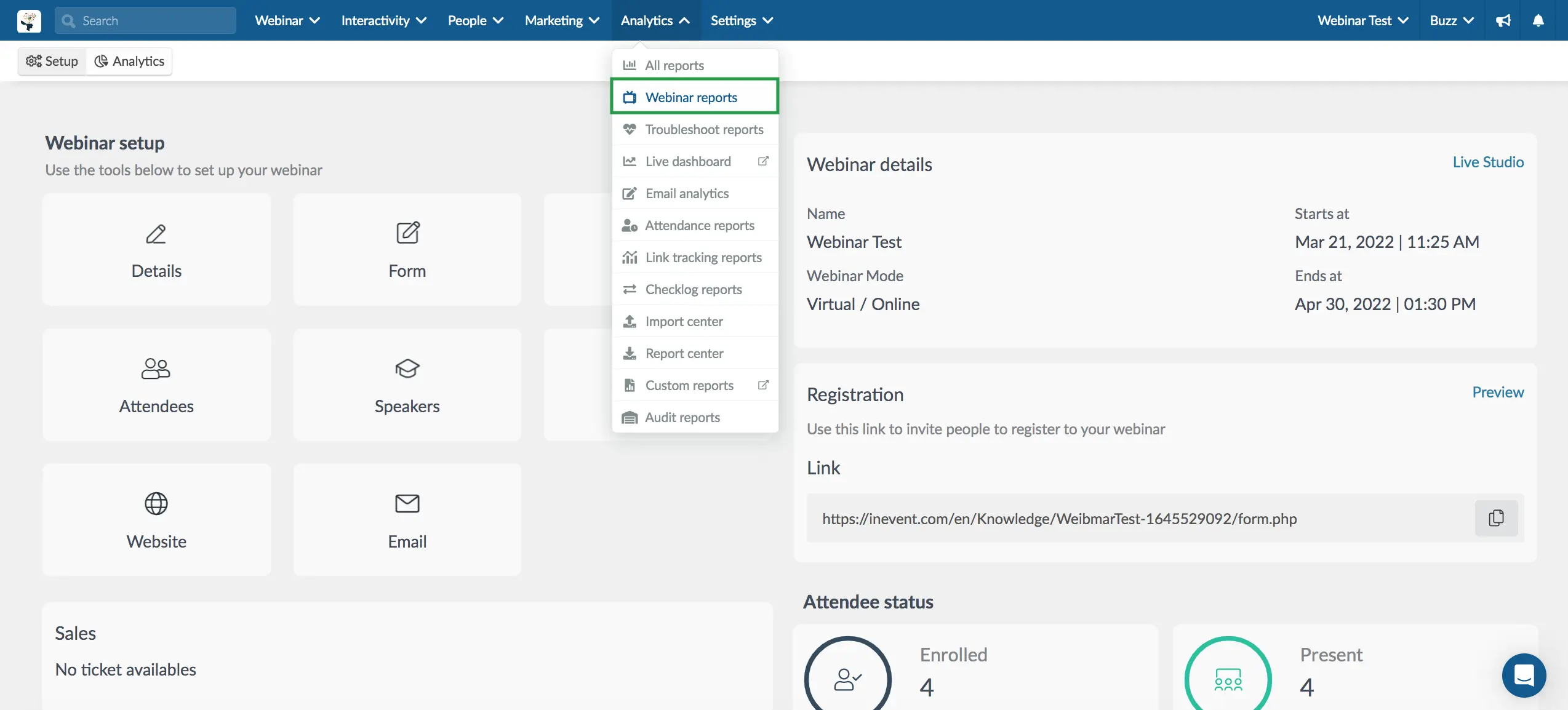
The main page contains general data and an overview of the analytics. Here you will find the number of online users over time and the Live performance of your Live stream.
You can also filter the report that appears on your main page to a specific date range using the date selector at the top left corner of your page. Simply click on the Clear button to remove the filter.
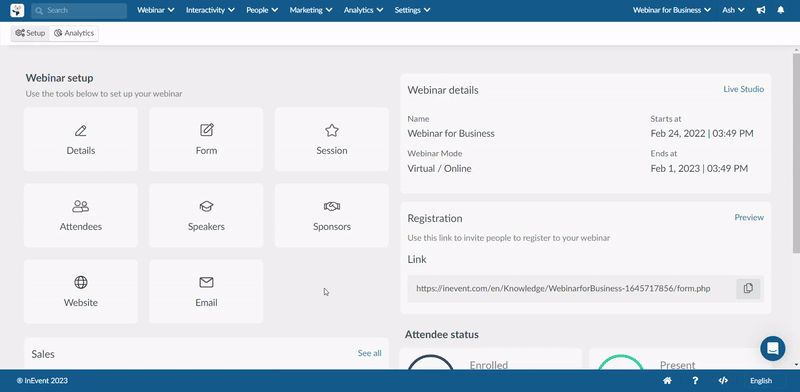
General data
At the top of the page, you will find 3 boxes with general information about the event
If you click View on the top right corner of each box, the statistics will appear:
- Users - Counts how many people have joined the Webinar session. By pressing View, you will see a user list ordered by highest total time viewed in the event, the number of activities, sponsors booth, meetings, and group rooms each attendee has joined, as well as total and unique views per attendee.

- Total Time - Total time spent by attendees in a session. By pressing View, you will see the total time and the amount of time the webinar has been viewed. This time comprises the views of all attendees at the webinar.
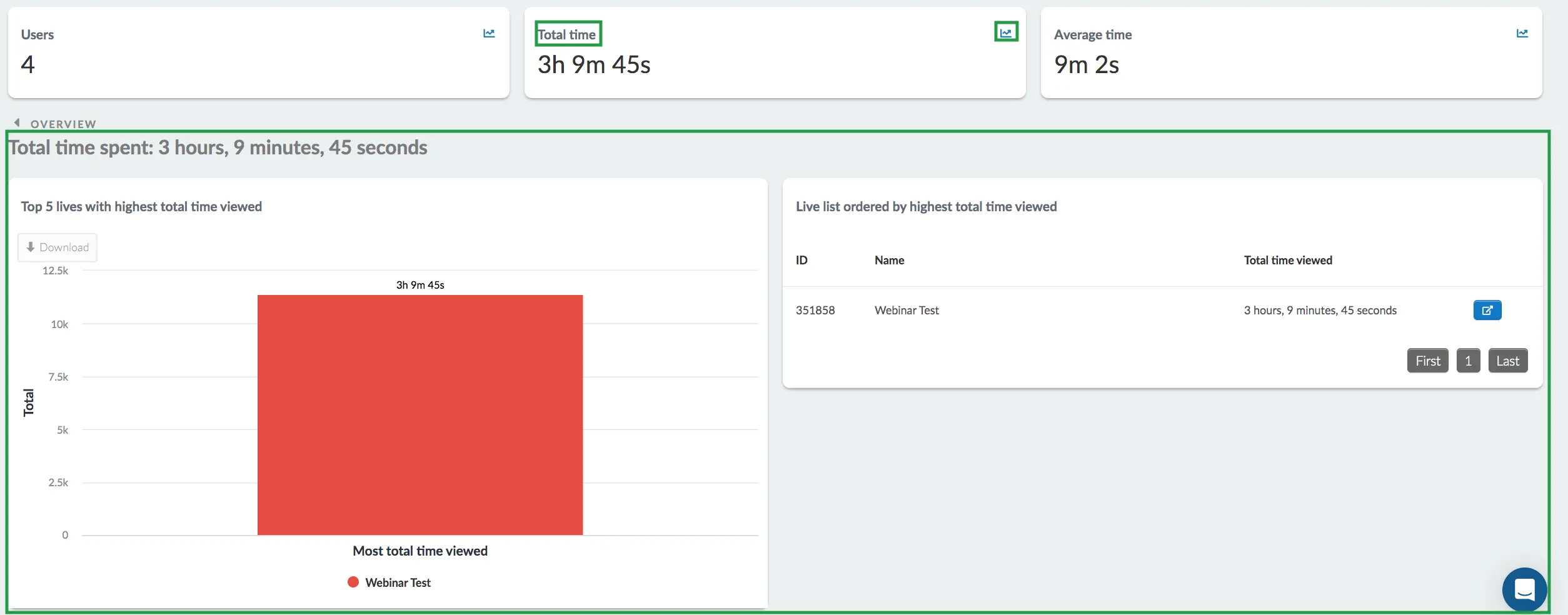
- Average time - Average time spent by attendees in a room. By pressing View, you will see a live list ordered by the highest average time viewed per room. For example, the average time spent in the Webinar Test session is 9 minutes, 2 seconds.
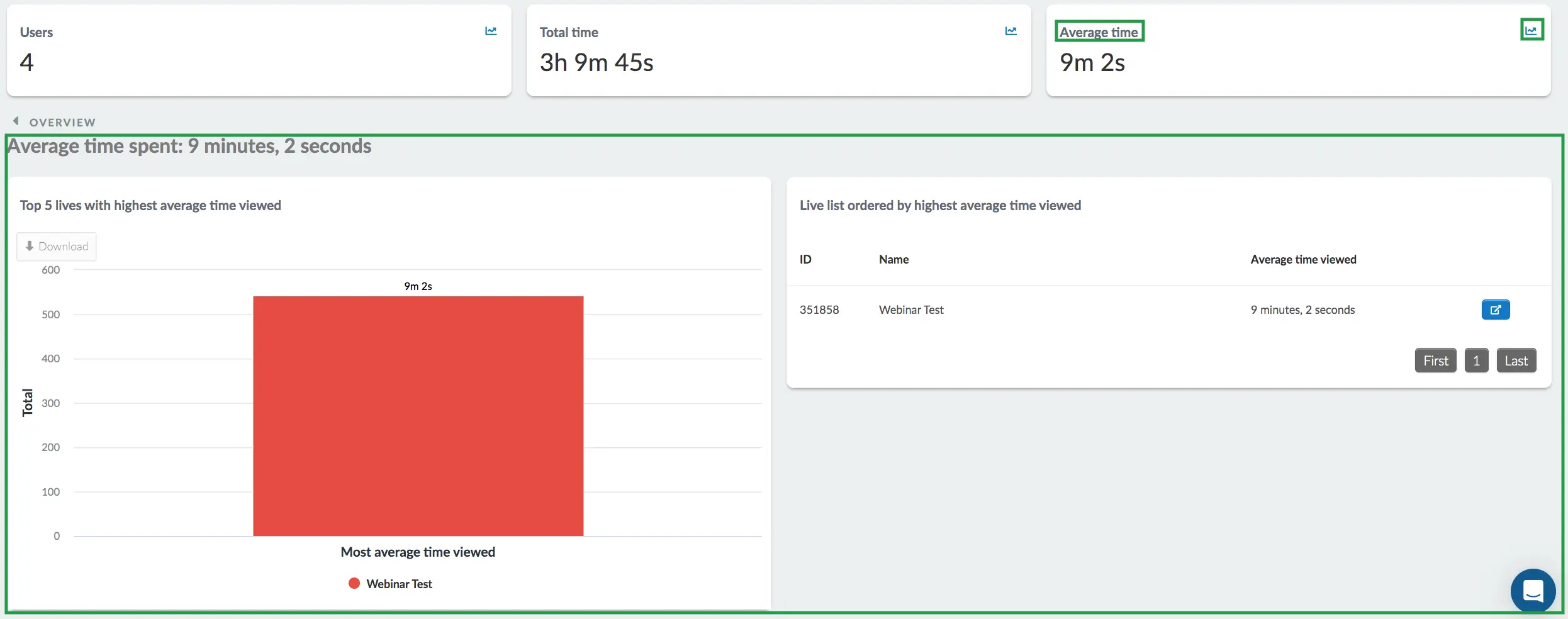
Overview
Here you can find two sections: Online users over time and Live performance.
Online users over time
Timeline
This line chart will show you the number of active attendees at certain points of time throughout the event. The green line shows the number of online users and the blue line shows the number of participants inside sessions.
You can define the period to be analyzed and shown in the graph. To do this, use the buttons highlighted in green in the image below.
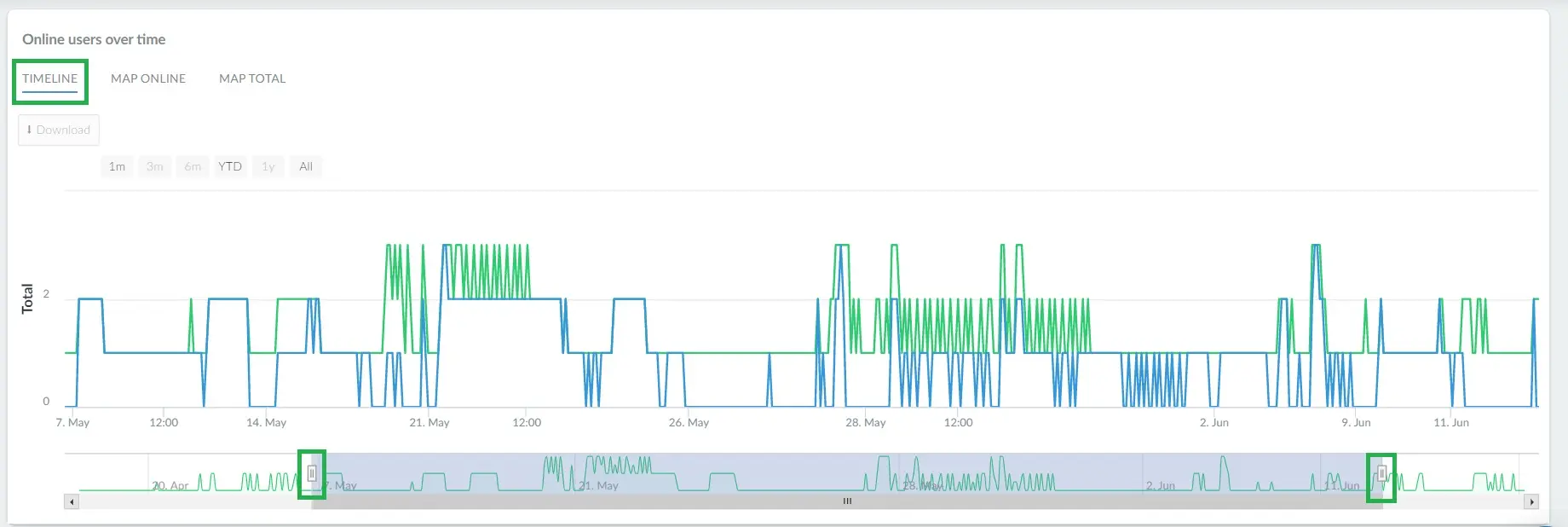
Map online
This map will display the users that are online at the moment in your Webinar. If you select World in the dropdown bar, you will see the top countries with the most online users. If you select United States, you will see the top states with the most online users.

Map total
This map will display every user who ever accessed your event in your Webinar regardless if they are online or offline at the moment. If you select World in the dropdown bar, you will also see the top countries with the most online users. If you select United States, you will see the top states with the most online users.
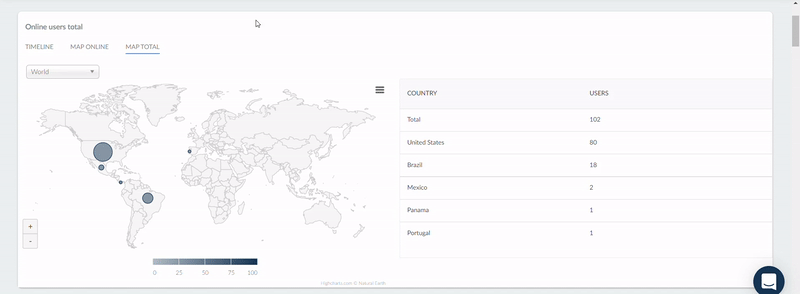
Live Performance
In this section you will see the information as follows:
- ID: The live ID of the session.
- Name: The name of the live session.
- Total views: Counts the total amount of times people have joined your session (for example if they have entered, left, then re-entered)
- Unique views: Counts each person who has joined your session.
- Retention: Percentage of people that have over 70% watch time of the total session. This percentage is calculated based on the start and end time of the session. Retention will not be calculated for Sponsor rooms or group rooms, as these rooms are available for the entire duration of the event, so they will display a Not apply label.
- Total time: Total time spent by attendees in a session.
- Average time: Average time spent by the attendees in a session.

You can click on the blue button on the right of the session to break it down:
- Name: Name(s) of the participant(s) who took part in the Live stream.
- Email: Email address(es) of the participants.
- Hits: Number of times that a user answered the attendance tracking pop-up window. To learn more about attendance tracking click here.
- Watch %: The green bar corresponds to the time the user spent watching the session when it was live, within the session date & time bounds. The yellow bar refers to the time the user spent in the room before or after the session date & time.
- Live watch time: This data refers to the time the user spent watching the session when it was live, within the session date & time bounds.
- Total time: Total time spent by attendees in a room, combining both Live + On Demand.

If you click the blue button again, you will see the number of times each user watched the Live stream.

Grouping and ungrouping reports
You can define if you'd like to display a listing of all your reports or if you'd rather have them grouped:
- Grouped users by ID - ID, name, email, total views, total time, average time
- Grouped users by Role field - role, total views, total time, average time
- Grouped users by Company field - company, total views, total time, average time
- Ungrouped - ID, name, email, duration, joined at, left at

How do I extract a report?
There are different types of reports that can be generated from the Webinar Analytics page:
- Single session report
- All sessions report
- Single user report
- All users report
Single session report
This contains reports of all attendees and their Live session logs for one session only in the Webinar. To extract a single session report, scroll down to the Live performance section, press the blue Open user statistics button beside the session you wish to extract a report for. Click on Edit > Report.
A spreadsheet containing information on the selected session will be sent to your email.
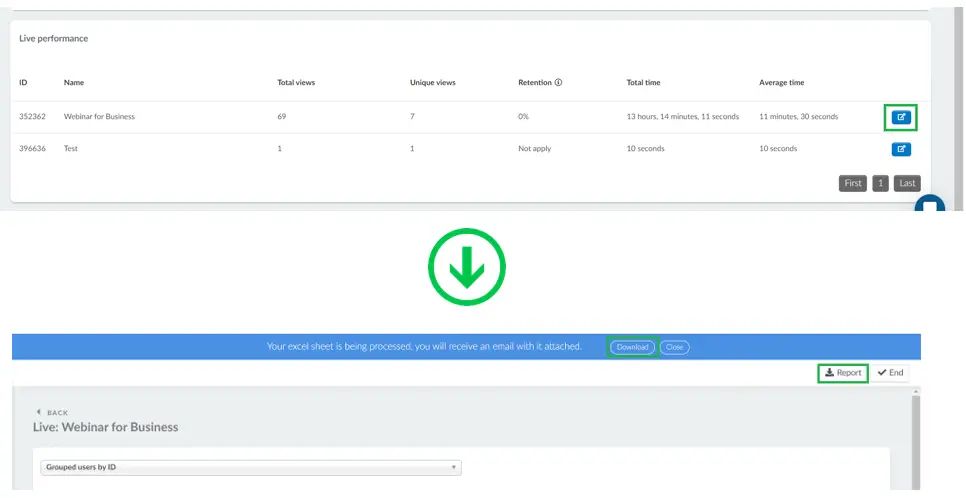
All sessions report
This contains reports of all live sessions in the Webinar. To extract a report on all your Live sessions, simply click on Edit > Report on the Webinar reports page.
A spreadsheet containing information on all Live sessions in your Webinar will be sent to your email.

Single user report
This report contains all logs of Live sessions attended by an attendee in the Webinar. To extract a report on the attendee, click on Users > locate the desired user from the list and click on the blue Open user statistics button, then press Edit > Report.
A spreadsheet containing information on all Live sessions attended by the user will be sent to your email.
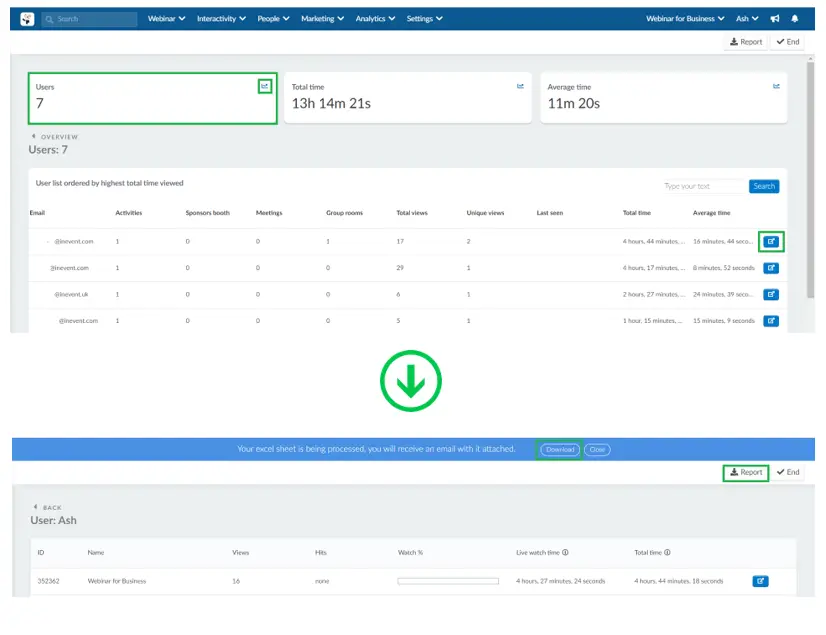
All users report
This contains reports of all attendees in your Webinar. To extract a report on all your attendees, simply click on Users > Edit > Report on the Webinar reports page.
A spreadsheet containing information on all attendees in your Webinar will be sent to your email.
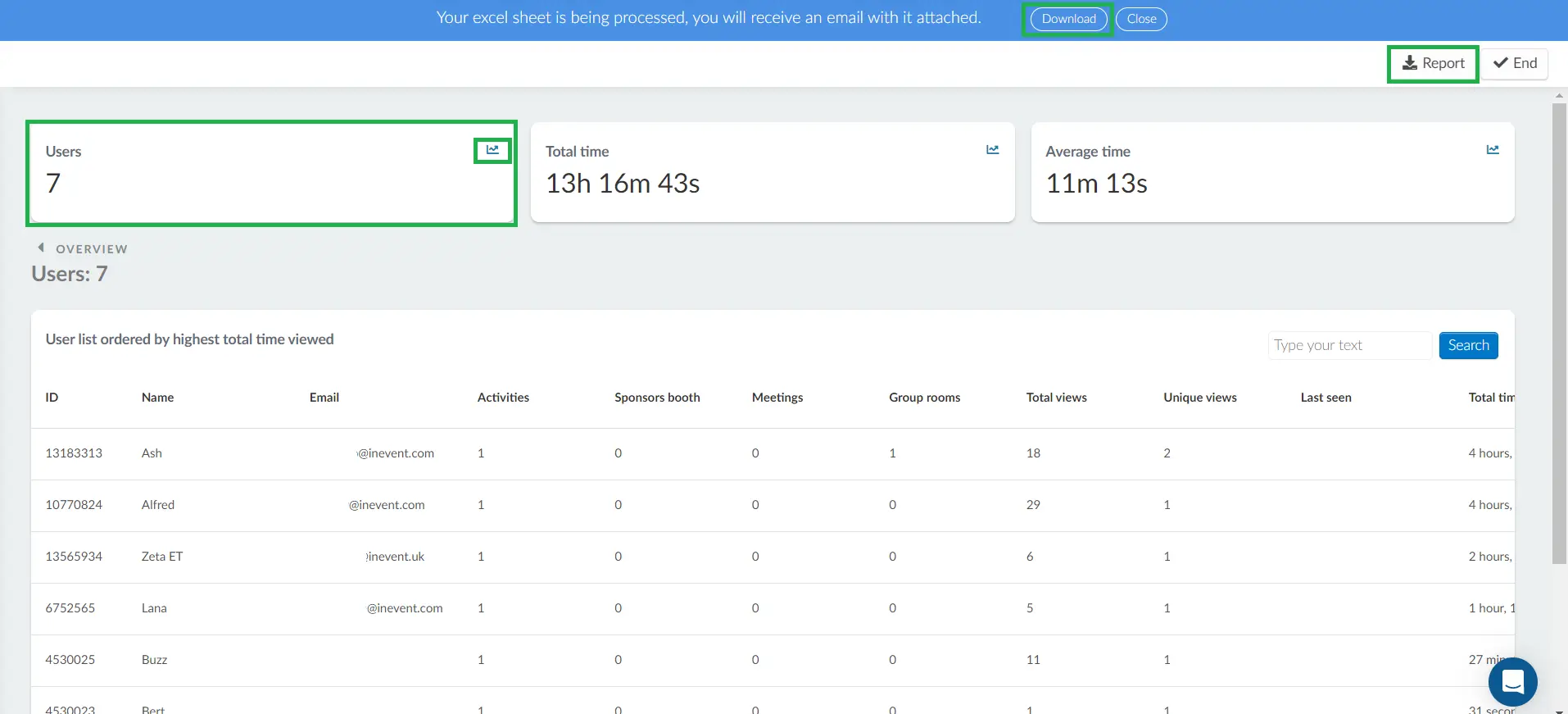
Analyzing the reports
Single session report
When you download the spreadsheet report of a single session, you will find the following information in the columns below:
- livePersonID: The identifier of the attendee who joined the session.
- liveID: The ID of the session itself (the one that shows up in the Webinar Live stream URL).
- personID: (the one that shows up in the backend URL of the People > Attendees page).
- username: The username of the attendee.
- name: The full name of the attendee - first name and last name.
- firstName: The first name of the attendee.
- lastName: The last name of the attendee.
- email: The email address of the attendee.
- role: The role of the attendee.
- company: The company of the attendee.
- telephone: The telephone number of the attendee.
- activities: If the session type is an activity, the entry will be 1.
- meetings: If the session type is a meeting, the entry will be 1. Not applicable in Webinars.
- sponsors: If the session type is a sponsor room, the entry will be 1. Not applicable in Webinars.
- groupRooms: If the session type is a group room, the entry will be 1. Not applicable in Webinars.
- totalViews: It displays the total amount of times attendees have joined the session (for example if they have entered, left, then re-entered).
- uniqueViews: It counts each attendee who has joined a room.
- sessionDuration: The duration of the session based on the start and end time.
- Date Joined: It shows the first time that the attendee entered the room.
- Date Updated: It shows the last time the attendee entered the room.
- totalTimeSpent: It shows the total time spent by an attendee in the room.
- avgTimeSpent: It shows the average time spent by an attendee in the room.
- attendanceHits: Number of times that an attendee answered the attendance tracking pop-up window. Only applicable to the Webinar Live stream.
- attendancePopus: Number of attendance pop-ups that were defined by the admin.
- Feedback(s): If you have added custom questions in your registration form, each question will appear here as a column.
- FeedbackDate: The date of custom question answer submission by an attendee.
- Tags: The tags attached to an attendee. Not applicabl to Webinars.
All sessions report
- eventID: The ID number of the Webinar itself which data is being reported.
- liveID: The ID of the session itself (the one that shows up in the Webinar Live stream URL).
- activityID: The ID of the session itself (the one that shows up in the backend URL - Webinar > Live stream).
- livePersonID: It's the identifier of the specific watched session . Every time an attendee opens and closes a session, a new ID is generated to track how long the person stayed there.
- personID: The ID of the attendee (the one that shows up in the backend URL of the People > Attendees page).
- name: It displays the name of the session.
- eventName: The name of the Webinar.
- eventNick: The event's nickname as it shows in the Webinar > Details.
- totalViews: It displays the total amount of times people have joined a session (for example if they have entered, left, then re-entered).
- uniqueViews: It counts each person who has joined a room.
- sessionDuration: The duration of a session based on the start and end time
- Type: It shows the room type, if it's an activity (Live stream) or a breakout room.
- attendeeWatchAvg: This shows the average number of attendees that engaged in a session. AttendeeWatchAvg is calculated as retention (%) multiplied by the number of unique views. The result is displayed rounded to the nearest whole number.
- Date Joined: It shows the first time that an attendee user joined a session.
- Date Updated: It shows the last time that an attendee joined a session.
- totalTimeSpent: It shows the total time spent by attendees in a session.
- avgTimeSpent: It shows the average time spent by attendees in a session.
- watchTimeSpent: It corresponds to the time spent by users watching the session when it was live, within the session date & time bounds.
- attendanceHits: Number of times that a user answered the attendance tracking pop-up window. Only applicable to the Webinar Live stream.
- attendancePopups: Number of attendance pop-ups that were defined by the admin.
- retentionRate: It displays the percentage of people that have over 70% of watch time. Applicable only to the Webinar Live stream.
Single user report
When you download the spreadsheet report of a single user, you will find the following information in the columns below:
- eventID: The ID number of the Webinar itself which data is being reported.
- liveID: The ID of the session itself (the one that shows up in the Webinar Live stream URL).
- activityID: The ID of the session itself (the one that shows up in the backend URL - Webinar > Live stream). Only applicable to a Live stream session.
- livePersonID: It's the identifier of the specific watched session . Every time an attendee opens and closes a session, a new ID is generated to track how long the person stayed there.
- personID: The ID of the attendee (the one that shows up in the backend URL of the People > Attendees page).
- name: It displays the name of the session.
- eventName: The name of the Webinar.
- eventNick: The event's nickname as it shows in the Webinar > Details.
- totalViews: It displays the total amount of times people have joined a session (for example if they have entered, left, then re-entered).
- uniqueViews: It counts each person who has joined a session. Only applicable to the Webinar Live stream.
- sessionDuration: The duration of a session based on the start and end time. Only applicable to the Webinar Live stream.
- Type: It shows the room type, if it's an activity (Live stream) or a breakout room.
- attendeeWatchAvg: This shows the average number of attendees that engaged in a session. AttendeeWatchAvg is calculated as retention (%) multiplied by the number of unique views. The result is displayed rounded to the nearest whole number.
- Date Joined: It shows the first time that an attendee joined a session.
- Date Updated: It shows the last time that an attendee joined a session.
- totalTimeSpent: It shows the total time spent by an attendee in a session.
- avgTimeSpent: It shows the average time spent by attendees in a session.
- watchTimeSpent: It corresponds to the time spent by an attendee watching the session when it was live, within the session date & time bounds. Only applicable to the Webinar Live stream.
- attendanceHits: Number of times that a user answered the attendance tracking pop-up window. Only applicable to the Webinar Live stream.
- attendancePopups: Number of attendance pop-ups that were defined by the admin.
- retentionRate: It displays if the attendee's watch time percentage is over 70%. Applicable only to the Webinar Live stream session.
All users report
When you download the spreadsheet report of all users, you will find the following information in the columns below:
- livePersonID: It's the ID of the specific watched session. Every time an attendee opens and closes a session, a new ID is generated to track how long the person stayed there.
- liveID: The ID of the session itself (the one that shows up in the Webinar Live stream URL).
- personID: The ID of the attendee (the one that shows up in the backend URL) in the People > Attendees page.
- username: The username of the attendees.
- name: The full name of the attendees - first name and last name.
- firstName: The first name of the attendees.
- lastName: The last name of the attendees.
- email: The email address of the attendees.
- role: The roles of the attendees.
- company: The companies of the attendees.
- telephone: The telephone numbers of the attendees.
- activities: The number of activities attended by each attendee.
- meetings: The number of meetings attended by each attendee. Not applicable to Webinars.
- sponsors: The number of sponsor rooms attended by each attendee. Not applicable to Webinars.
- groupRooms: The number of group rooms attended by each attendee.The breakout rooms created within your Webinar Live stream, will appear as the group room.
- totalViews: It displays the total amount of times attendees have joined all sessions.
- uniqueViews: It counts all the attendees that have joined a session.
- sessionDuration: It shows the summed up duration of all sessions each user joined based on their start and end times.
- Date Joined: It shows the time that each attendee entered their first session.
- Date Updated: It shows the time that each attendee entered their last session.
- totalTimeSpent: It sums the total time spent by each attendee in all the sessions.
- avgTimeSpent: It shows the average time spent by an attendee in all the sessions.
- attendanceHits: It shows the number of times that each user answered the attendance tracking pop-up window.
- attendancePopus: It shows the number of attendance pop-ups that were defined by the admin.
- Feedback(s): If you have added custom questions in your registration form, each question will appear here as a column.
- FeedbackDate: The date of custom question answer submission from each attendee.
- Tags: The tags attached to each attendee. Not applicable to Webinars.
